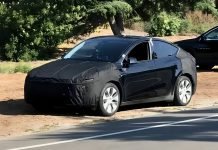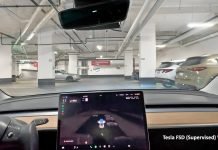Automobile enthusiasts were spellbound with the cars that Tata Motors has showcased at the 2018 Auto Expo. The next opportunity was the 88th International Geneva Motor Show for Tata Motors to exhibit their technological competence. This was the 20th year at this event Tata Motors so to celebrate the run and to make their presence felt. By exhibiting the E-Vision all-electric concept sedan, the H5X and the 45X accomplished just the same. Noticeably the three cars share platforms.
A suitably modified dedicated EV architecture, addressing a plethora of performance traits for long-range travel was chosen for the E-Vision sedan. It has been speculated that the production of the sedan is expected to start in 2021.
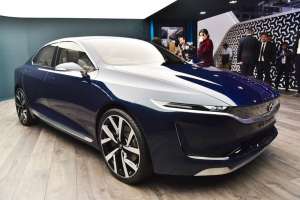
Things to Know About Tata EVision
Performance
The Tata EVision is expected to offer a range of 300 km to 400 km on a single charge. Like any other efficient electric car, the Tata EVision also uses a lithium-ion battery pack. Although the battery capacities and electric motor output haven’t been disclosed yet, it’s safe to assume that it will provide enough juice for top speeds up to 200 km/h. The sedan will produce enough torque to propel the car from 0 to 100 km/h under 7 seconds.
This might not seem to be a Tesla beating figure but this surely gives a tough competition to the Skoda’s Octavia VRS. Also, the sedan will come equipped with a double motor setup mounted on each axle mated to an automatic transmission.
Interior and Exterior Design
The sedan is designed to seat 5 passengers comfortably with all that space because of lesser components and a flatbed. Coming to the size of the car the length is 4400 mm and width is 1833 mm with a height of 1499 mm. The wheelbase is 2695 mm with a decent ground clearance of 195 mm. The curb weight of the car is 1377 kg.
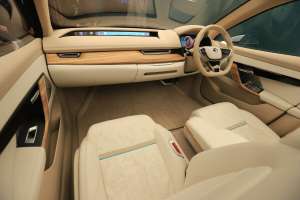
Taking a look at the interior a multilayered dashboard is seen featuring a light beige theme with wood highlighters. Along with the regular instrument cluster, an additional pop-out instrument panel is provided. Without a central console, there is ample room. The infotainment system extends out of the dashboard. Other tech features include analytics, a Prognostics controller to forecast service requirements, HMI, cloud computing, geospatial mapping with ADAS.
The Tata EVision could be a catalyst to the EV market in India, pushing all automakers to produce EVs as mainstream automobiles. Tata has benefitted a lot from its alliance with Jaguar and Land Rover. Technologies are being co-developed for various markets globally.
The design language being followed now is the latest impact “2.0”. The sharp edges all around the car are a distinguishing trait of this design language. The headlights Tata EVision with the uncanny resemblance to the ones on the BMW i8, use LED headlights instead.
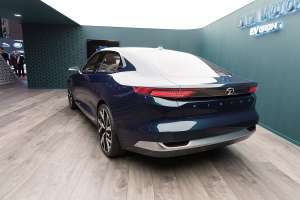
The rear design is equally impressive, with humanity lines running below the front grill and headlamp across the corners. The all-aluminum construction from the A-pillar to C pillar gives the body its strength and light weightiness also giving it a coupe-style roofline. The front grill is a single transparent unit displaying the night theme. The Tata EVision uses the advanced modular OMEGA ARC platform being shared by H5X and 45X. The Tata EVision sedan concept is the third model to use this new Impact 2.0 design language after the 45X hatchback and the H5X SUV. The OMEGA architecture is not an all-electric platform but holds the possibility of forming the basis of Tata’s first-ever attempt at giving a D segment sedan to rival the likes of Skoda Octavia, Toyota Corolla or Hyundai Elantra.
Conclusion
It is very obvious that right now India is not ready to go all-electric, but the pace is fast and the future is promising. Tata is all set to enter the EV sector with the Tigor EV under the implementation of the CAFE norms from 2022 requiring the automakers to ensure minimum average fuel efficiency to the entire lineup, with the EV and Hybrid vehicles benefiting in this direction. As mentioned earlier Tata Evision sedan will be available by 2021-2022, being the last to arrive. The possible arrival of Tata Altroz EV and 2 other electric SUVs based on the Tata Harrier and Tata H2X, will be based on the Nexon EV having the Ziptron technology.




